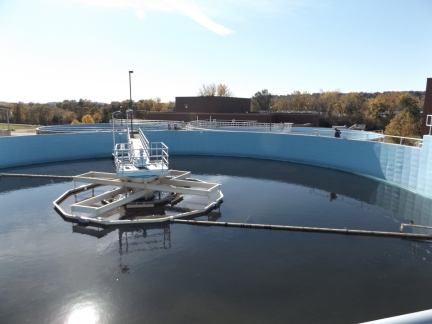Wastewater facilities

Much of Minnesota has hard water, which prompts people to use water softeners. Water softeners need salt (which contains chloride) to recharge their softening capacity, and the resulting salty brine is discharged to municipal wastewater treatment plants in most cities. The plants are not designed to remove chloride from wastewater, so the chloride ends up in the receiving water, usually a lake, river, or stream.
The MPCA has required several wastewater treatment plants (WWTPs) to monitor for chloride in their discharge since 2009. So far, more than 100 Minnesota WWTPs have the potential to contribute levels of chloride higher than allowed by the standard, which is 230 mg/L for chronic levels and 860 mg/L for acute levels.
The common approach to reduce pollutants in wastewater is to assign a limit in facility permits, requiring WWTPs to adjust or invest in their processes so they can lower the amount of the specific pollutant in the wastewater. However, there is no economically feasible way for plants to remove chloride from wastewater. The only available method (reverse osmosis) is hugely expensive both to install and maintain.
The MPCA commissioner formed a work group of community representatives to study the chloride problem. This group of eight municipal representatives and two consultant engineers made recommendations that were approved in June 2017.
Whatever permitting tool is chosen, the goal is the same: Reduce the amount of chloride and other salts entering the wastewater plant. Work continues on the best ways to achieve this. MPCA has developed a strategy to help municipal permittees start developing a plan.
Chloride standard variances for wastewater facilities
Stormwater
Industrial stormwater
Industrial stormwater permittees must:
- enclose or cover storage piles of salt or piles containing salt to prevent exposure to precipitation, except where stormwater is routed to a sanitary sewer, sump, or other proper collection system (i.e., not the stormwater drainage system) or the lack of enclosure or cover is authorized under a separate NPDES/SDS permit
- control exposure resulting from the adding or removing material with appropriate measures (e.g., good housekeeping, diversions, and containment)
For more information, refer to the industrial stormwater general permit requirements.
Municipal stormwater
Municipal stormwater permittees must:
- distribute educational materials or equivalent outreach to residents, businesses, and institutions, focused on the impacts of deicing salt, methods to reduce its use, and proper storage
- implement best management practices at permittee owned/operated salt storage facilities, such as covering and storing salt indoors on an impervious surface
- require proper salt storage at commercial, institutional, and non-NPDES permitted industrial facilities.
- keep an inventory of permittee owned/operated salt storage areas
- implement a written snow and ice management policy for winter maintenance professionals who work for the permittee, and provide them with training on water-quality protection and reducing de-icer use
All individuals that perform winter maintenance activities for the permittee should receive training that includes the importance of protecting water quality, BMPs to minimize the use of deicers, and tools and resources to assist in winter maintenance. The permittee may use training materials from MPCA's Smart Salting training.
TMDL requirements
If the permittee has an applicable waste load allocation where a reduction in pollutant loading is required for chloride, they must:
- document the amount of deicer applied each winter maintenance season to all permittee owned/operated surfaces
- assess their winter maintenance operations to reduce the amount of deicing salt applied to permittee owned/operated surfaces and determine current and future opportunities to improve BMPs; the permittee must document the assessment
See the Minnesota Stormwater Manual for guidance on completing your TMDL reporting form.
Chloride and the new MS4 permit
MPCA staff led a discussion about the new chloride management requirements in the 2020 MS4 permit and the tools, resources, and training available to assist permit holders. Local MS4 partners shared their experience and expertise on successfully implementing chloride reduction actions to improve their winter maintenance operations and protect water resources.
For more information, review the municipal stormwater general permit requirements.